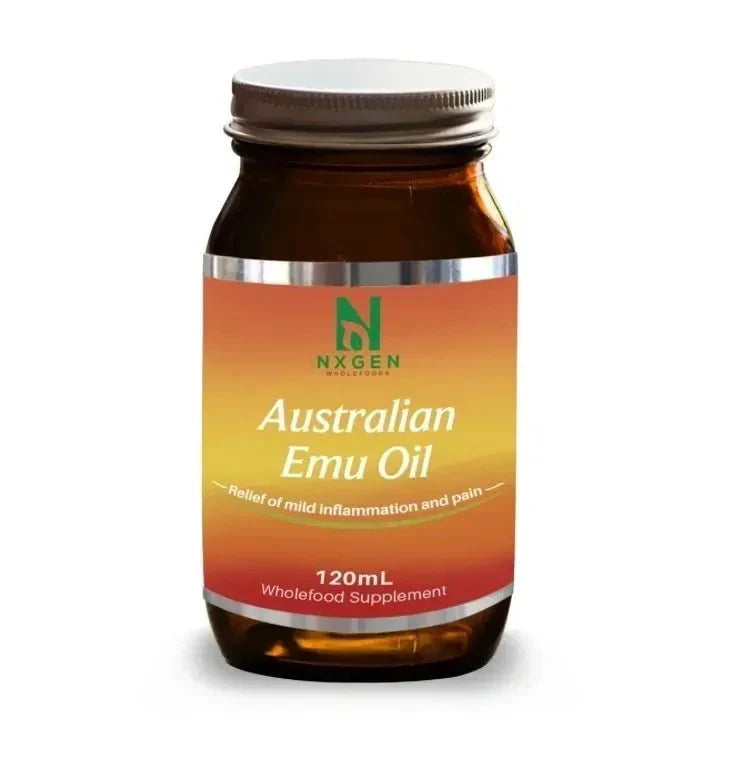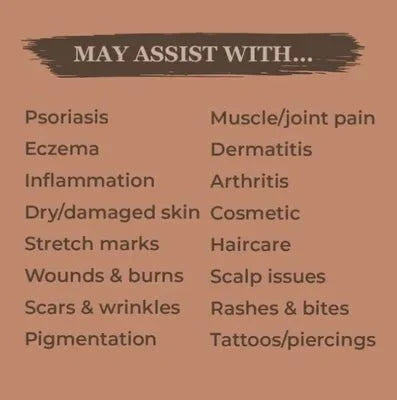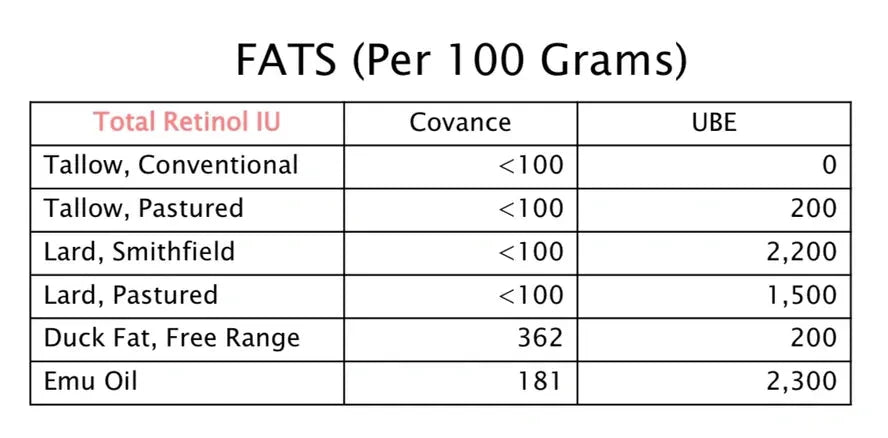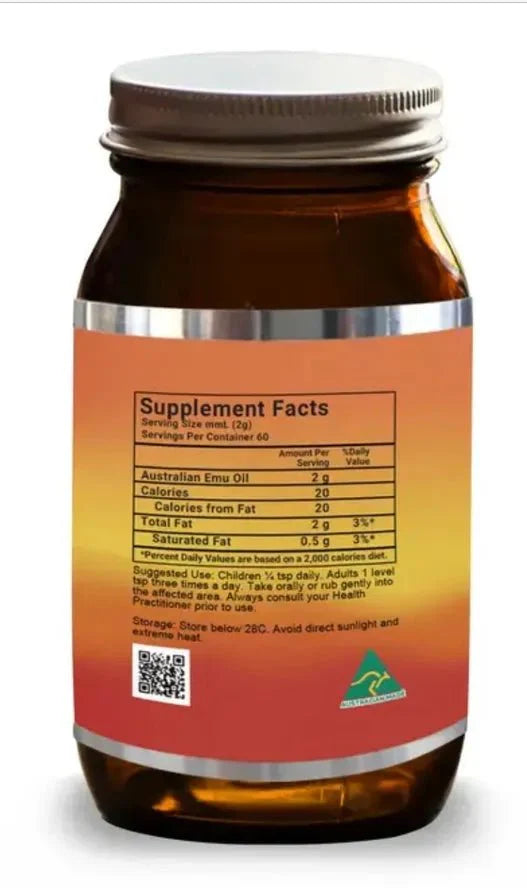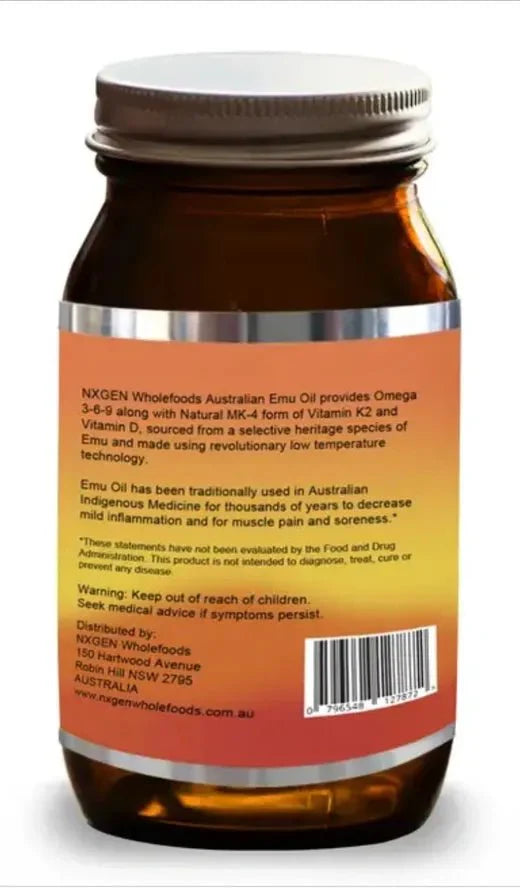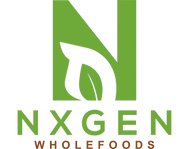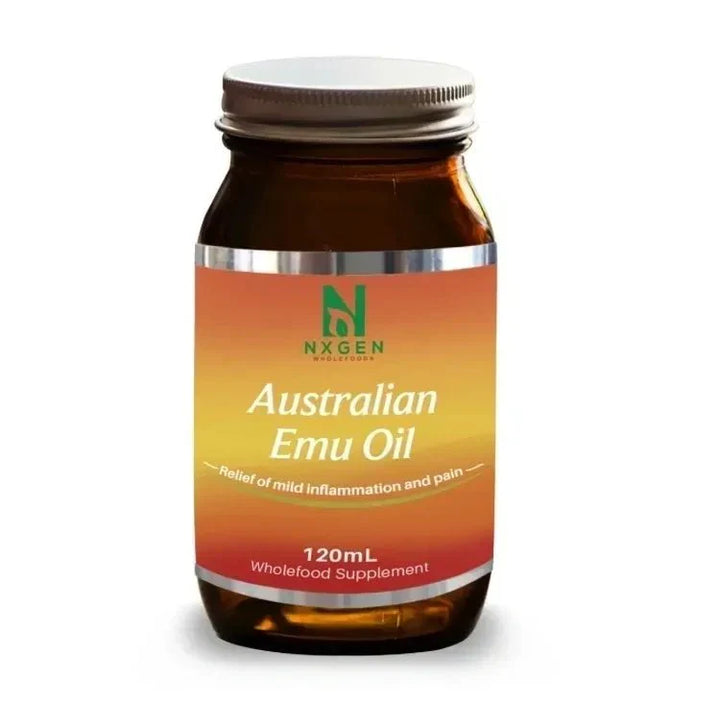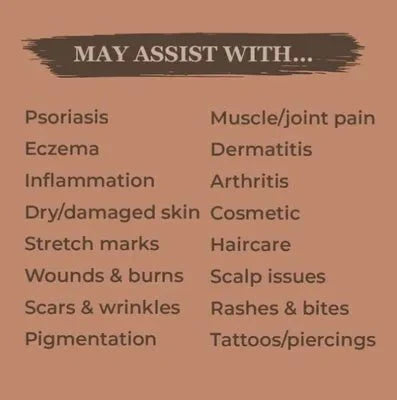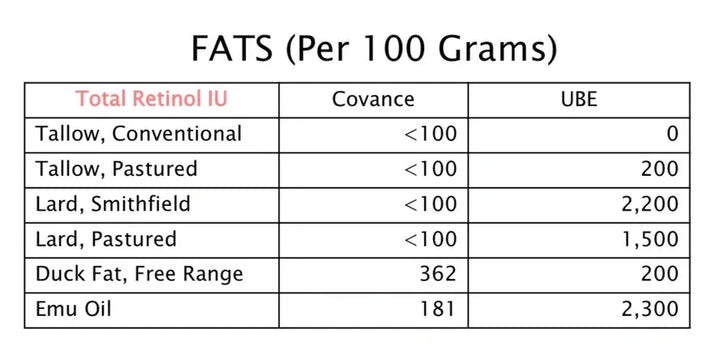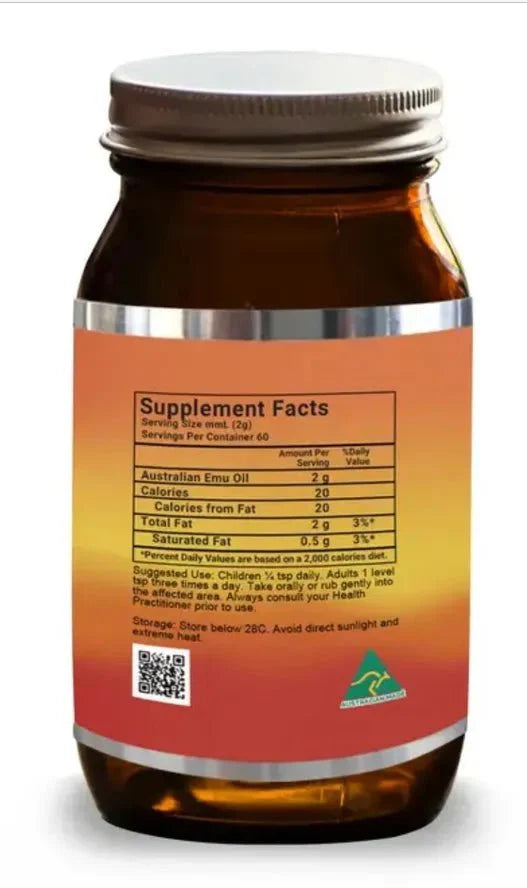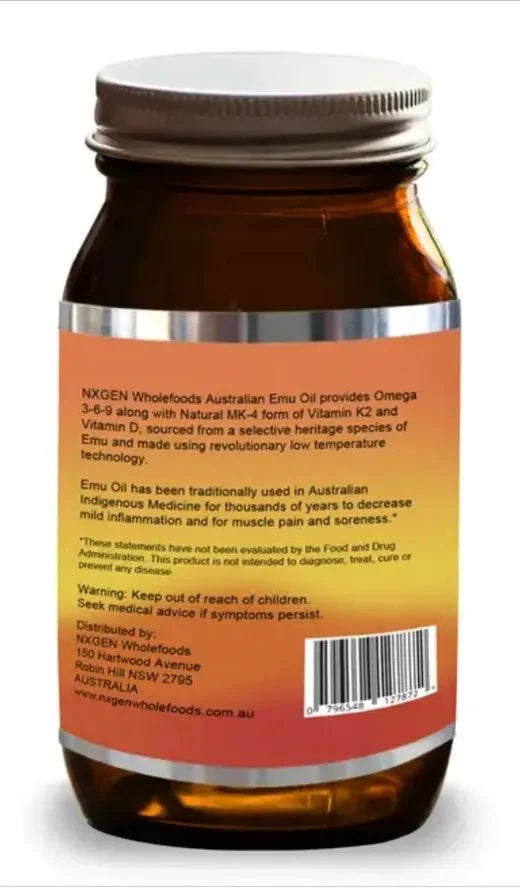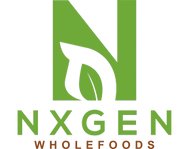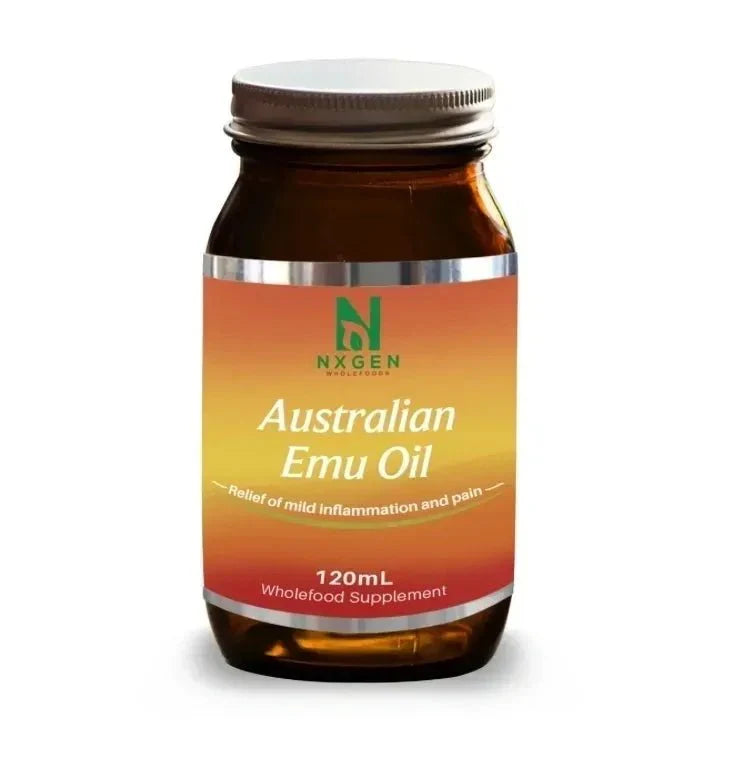Nxgen Emu Oil 120ml
“Australian Aboriginal descendants call it the "sacred oil" and recognise it as the most powerful anti-inflammatory with exceptional skin penetrating properties,” Dr Suzanne Mashtoub.
NXGEN Emu Oil has no added ingredients and is aimed to provide relief from mild pain, improve skin disorders, aid wound healing, as well as help with many other health issues.
NXGEN Emu Oil consists of not only Omega 3, 6, and 9, but also Vitamins A, D3, E and K2 (as MK-4).
Omegas 3, 6, and 9 contain essential fatty acids that are necessary for good health. They have anti-inflammatory properties, to help provide healthy skin, hair and nails.
NXGEN Emu Oil typically contains:
Myristic Acid 0.44%
Palmitic Acid 22.6%
Palmitoleic Acid 7.6%
Stearic Acid 7.1%
Oleic Acid 53.7%
Conjugated Linoleic Acid 4.7%
Linolenic Acid 0.6%
Dr Terry Wahls [2] states
Vitamin K2 MK-4 is responsible for hundreds of life-sustaining and life-giving processes at the genetic and metabolic level, Vitamin K2 is really significant because:
- Activates the vitamin K dependent proteins involved in myelin production and immune system modulation
- It’s neuroprotective
- Researched to be proven to repair and restore the gut
- When the vitamin K dependent proteins are activated, it’s beneficial primarily for the nervous system
- Helps promote homeostasis in the body overall
- Researched to reduce mitochondrial dysfunction
- Increases the mitochondria ATP production
- Increases glutathione production
- Reduces oxidative stress
- Activates a couple of detoxification pathways—the nuclear factor antioxidant pathway and oxidative phosphorylation
Why Select NXGEN Emu Oil
NXGEN Emu Oil is provided in a glass jar to keep oxygen out and improve quality. NXGEN Emu Oil is made using a low temperature method to retain the efficacy of all the active ingredients. There are absolutely no fillers, no additives, no chemicals used or added. 100% pure.
What is Emu Oil
NXGEN Australian Emu Oil is different from any other traditional supplement oil on the market. At certain times of the year, emu will go into a torpor, much like a hibernation. They will go months without eating or even moving. They store up fat prior to this in order to live through the time without food. The emu oil used by the Aboriginals and harvested by NXGEN is life-sustaining fat. Super nutritious and loaded with vitamins.
NXGEN Australian Emu Oil is an excellent source of:
- Essential fatty acids: omega-3, omega-6 and omega-9
- Vitamin K2 MK-4, Dr. Weston A. Price’s “Activator X”
- Vitamin D3
- Vitamin E
- CLA - conjugated linoleic acid
Ingredients:
100% pure, high-quality emu oil, nothing added or removed!
FREQUENTLY ASKED QUESTIONS?
How do I take Emu Oil orally?
This is the best way to consume Emu Oil as it's Virgin Emu Oil. Many people love and take Emu Oil raw, with water. Taking Emu Oil orally is the best way to improve your health as it will help treat the root cause and provide Omega 3 6 9 and K2 (MK4) and D so the body can benefit most. Emu Oil by itself is much easier than swallowing a capsule. Using a teaspoon scoop out the emu oil onto the teaspoon and place the Emu Oil on the tongue and swallow with water, the same way you woulda capsule. It's that easy and much cheaper than capsule versions. There is no after taste and your body will be using the nutrients the same way of our ancestors and traditional cultures.
Does Emu Oil Deteriorate Over Time?
No, providing your Emu Oil is stored correctly per the label with the lid on it will retain the nutrients for years. Emu Oil doesn't need to be stored in the fridge. It's characteristic and quality is like a good wine. We store our Emu Oil the same way as wine. It is stored in stainless steel vats using a CO2 blanket which stops oxidisation.
The Grass-Fed Vitamin
We call the MK4 subform of vitamin K2 The Grass-Fed Vitamin because meat, milk, eggs, and fat from pasture-raised or grass-fed animals provide the main source of K2-MK4. These animals convert the vitamin K1 in the grass into vitamin K2-MK4. (See Rhéaume-Bleue, 2011, p. 41 for first known usage of the term "The Grass-Fed Vitamin" to describe vitamin K2. More specifically, "The Grass-Fed Vitamin" here refers to K2-MK4, the form of vitamin K2 made by animals eating grass.)
When we eat grass-fed animal foods, we benefit from the Grass-Fed Vitamin. K2-MK4 benefits heart, bones, brain, immunity, blood sugar, and more, as discussed below.
Because of the switch in the 1900s from eating grass-fed to grain-fed animals, deficiency of K2-MK4 has become extremely widespread. You are especially likely to be deficient in vitamin K2-MK4 if you eat processed foods and have insufficient animal based nutrition in the form of that from grass-fed animal foods.
Why Haven't I Heard of K2-MK4 Before If It's So Important?
- The importance of vitamin K2-MK4 is more recently discoveredthan the other vitamins.
- K2-MK4 still hasn't been recognised as a separate nutrient by many authorities. It remains omitted from most nutrient databases, guidelines, multivitamins, and fortified foods.
- High-fat, grass-fed animal foods are the best sources of K2-MK4, as discussed more below. The replacement of pastured animal farming with grain feeding means that most people in developed nations are deficient in K2-MK4.
- K2-MK4 deficiency symptoms develop slowly. It may take decades to notice changes in heart and bone health, such as arterial congestion and bone decay.
- K2-MK4 deficiency may pass congentially to newborns, whose parents may not be aware that impaired growth of teeth, jaw, and bones, or poor immunity, may relate to deficiency of the Grass-Fed Vitamin.
- Low-fat diets leave us deficient in the crucial fat-soluble Activator vitamins (retinol-A, D, and K2-MK4).
- The richest sources of K2-MK4 are exactly those foods that mainstream nutrition until now has shunned: pastured fatty meats, grass-fed butter, egg yolks, cheeses, and even goose liver — as well as one traditional food discovered to be the densest K2-MK4 source: emu oil (VitaK BV, 2015).
- These are the reasons why you may not have heard of K2-MK4 before, and also why it's especially important for you to take action to restore the missing K2-MK4 in your daily diet.
Am I Getting Enough K2-MK4?
K2-MK4 is found mainly in high-fat, grass-fed, animal foods.
-
Diet: Are you eating a variety of the high-K2-MK4 foods, at least two to three servings a day? Foods include:
- grass-fed meat and fats
- dark meat chicken
- egg yolks
- certain cheeses, including Dutch Gouda, Edam, and Maasdam; Norwegian Jarlsberg; French Brie, Roquefort, and Münster; British Stilton; Italian Gorgonzola; and Swiss Emmenthal
- Australian emu oil
- goose liver
- Grass-Fed Sources: Are your animal products coming from grass-fed or pasture-raised sources? When animals eat grass, they convert some K1 in grass into K2-MK4 animal bioactive form. Grass-fed and responsibly raised animal foods may contain many times more K2-MK4 than grain-fed animal foods (and many times more of other nutrients too!). Seek higher quality animal foods from local, conscious, and regenerative farmers.
How Much K2-MK4 Do I Need?
- Common recommendations for K2 (including MK-4 and other forms) are 100 to 200 micrograms per day and sometimes more (Kresser 2017 & 2019; Masterjohn 2016 & 2019; Mercola 2022; Rhéaume-Bleue 2016).
- A small amount of K2-MK4 (a few micrograms) usually seems to be enough, but is needed more than once daily, preferably with almost every meal. 1/4 to 1/2 tsp emu oil three times a day may be the easiest way to do this, at any meal when you are not otherwise eating grass-fed or pasture-raised fatty animal foods. Dr Weston A Price in his book
In his book, Nutrition and Physical Degeneration, reports using one-half to one and one-half teaspoons per day, which translates to a range of 520 ng to 1560 ng, or 0.520 mcg to 1.560 mcg. Weston A Price recommend 5.2 to 15.6mcg per day Of K2 as MK4.
How to Eat Emu Oil?
- Emu oil may be eaten mixed with other Activator-rich foods in Activator Goo recipe, similar to Dr. Weston A. Price's famous oil mixture.
- Add after cooking, and just before eating.
- Shake emu oil well before use.
- Store at room temperature, away from direct sunlight.
Is K2-MK4 a "Yin" or a "Yang" Vitamin?
Vitamin K2-MK4 is a very "yang" vitamin, in traditional Chinese and macrobiotic terms, and in the terminology of Dr. Larry Wilson (2021). "Yang" in this context means warm, stabilizing, and grounding. K2-MK4 is a more yang vitamin because it is fat-soluble, and comes from animal sources raised in a natural way. K2-MK4 tends to stabilize the calcium in the body, and oppose the "yin" condition of calcification of the soft tissues.
In contrast, K1 and K2-MK7 are more "yin" forms of vitamin K. "Yin" in this context means cooler, destabilizing, or more chaotic. K1 and K2-MK7 are more yin because they are derived from plants (K1) or from bacterial fermentation (K2-MK7).
They require conversion steps in one's body to make K2-MK4, and they may accumulate if those conversion steps aren't functioning properly. Therefore, K1 and K2-MK7 are more likely than K2-MK4 to induce imbalances with other nutrients.
Like other isolated nutrients, K2-MK4 can become "yin" and induce nutrient imbalances if given as a synthetic supplement in unneeded megadoses. However, in appropriate food-based amounts, yang vitamins like K2-MK4 are much needed today to upgrade our bodies.
Frequently Asked Questions
Why is Emu Oil considered better than Fish Oil?
Fish oil is extracted from the fat on the skin of fish and purified at much higher temperatures. Emu oil on the other hand is melted fat rendered and purified at much lower temperatures and provides Omega 3 6 & 9 as well as bioavailable fat soluble vitamins ADE&K.
Is the 425 mcg of k2 the total for the whole bottle?
Yes, the test results by show K2 is present as 4.2mcg per gram of emu oil. The 425mcg is per jar.
4200ng/g equals 4.2mcg/g so in one jar we expect 425mcg of K2 as MK4.
What is the recommended daily amount of vi K2 as MK4?
Weston A Price Foundation suggest a daily dose of between 5.2 & 15.6mcg/day.
What is the serve size and best way to take Emu Oil for Adults and Kids?
Put the jar in the fridge so the emu oil is firm and easy to scoop out with a teaspoon.
For Adults use a level teaspoon 3 x a day. Rest the Emu Oil on the tongue and swallow down with a glass of water.
For children use half a teaspoon a day. Mums add Emu Oil to the kids vegemite or honey sandwich, add to porridge or puree fruit or mix in their yoghurt or mash potato or mix with gravy and sauce. Do not add to hot food as it reduces the effectiveness.
I’ve noticed all the jars are 2/3’rds full is this the norm to expect?
Yes 2/3 level is normal.
When we fill 120ml in each jar the emu oil is at 25C and all liquid. At cooler temps eg 14 Celsius the emu oil can solidify and there can appear to be less in the jar. Each jar is filed with 120ml
FDA STATEMENT*
Any statements made on this website have not been evaluated by the Therapeutic Goods Administration (TGA) and Food and Drug Administration (FDA). Product information and statements made are not intended to diagnose, prevent, treat or cure any disease.
References
- Akbulut, A. C., Pavlic, A., Petsophonsakul, P., Halder, M., Maresz, K., Kramann, R., & Schurgers, L. (2020). Vitamin K2 needs an RDI separate from vitamin K1. Nutrients, 12(6), 1852. https://doi.org/10.3390/nu12061852.
- Alam, A., Woo, J. S., Schmitz, J., Prinz, B., Root, K., Chen, F., Bloch, J. S., Zenobi, R., & Locher, K. P. (2016). Structural basis of transcobalamin recognition by human CD320 receptor. Nature Communications, 7, 12100. https://doi.org/10.1038/ncomms12100.
- Barber, E. F., & Cousins, R. J. (1987). Induction of ceruloplasmin synthesis by retinoic acid in rats: influence of dietary copper and vitamin A status. The Journal of nutrition, 117(9), 1615-1622.https://doi.org/10.1093/jn/117.9.1615.
- Bellinge, J. W., Dalgaard, F., Murray, K., Connolly, E., Blekkenhorst, L. C., Bondonno, C. P., Lewis, J. R., Sim, M., Croft, K. D., Gislason, G., Torp-Pedersen, C., Tjønneland, A., Overvad, K., Hodgson, J. M., Schultz, C., & Bondonno, N. P. (2021). Vitamin K intake and atherosclerotic cardiovascular disease in the Danish diet cancer and health study. Journal of the American Heart Association, 10(16), e020551.https://doi.org/10.1161/JAHA.120.020551
- Bento, I., Peixoto, C., Zaitsev, V. N. & Lindley, P. F. (2007). Ceruloplasmin revisited: structural and functional roles of various metal cation-binding sites. Acta Crystallographica Section D: Biological Crystallography, 63(2), 240-248.https://doi.org/10.1107/S090744490604947X.
- Booth, S. L. (1997). Skeletal functions of vitamin K-dependent proteins: Not just for clotting anymore. Nutrition Reviews, 55(7), 282-284.https://doi.org/10.1111/j.1753-4887.1997.tb01619.x
- Booth, S. L., Shea, M. K., Barger, K., Leurgans, S. E., James, B. D., Holland, T. M., Agarwal, P., Fu, X., Wang, J., Matuszek, G., & Schneider, J. A. (2022). Association of vitamin K with cognitive decline and neuropathology in community-dwelling older persons. Alzheimer's & Dementia: Translational Research & Clinical Interventions, 8(1), e12255.https://doi.org/10.1002/trc2.12255
- Chatron, N., Hammed, A., Benoît, E., & Lattard, V. (2019). Structural insights into phylloquinone (vitamin K1), menaquinone (MK4, MK7), and menadione (vitamin K3) binding to VKORC1. Nutrients, 11(1), 67. https://doi.org/10.3390/nu11010067.
- Cranenburg, E. C., Schurgers, L. J., & Vermeer, C. (2007). Vitamin K: the coagulation vitamin that became omnipotent. Thrombosis and Haemostasis, 98(07), 120-125.https://doi.org/10.1160/TH07-04-0266.
- Dalby, M. (2014, March 10). The menaquinone (vitamin K2) content of animal products and fermented foods. The Call of the Honeyguide. https://honey-guide.com/2014/03/10/menaquinones-k2-and-phylloquinone-k1-content-of-animal-products-and-fermented-foods/
- Ellis, J. L., Fu, X., Karl, J. P., Hernandez, C. J., Mason, J. B., DeBose-Boyd, R. A., & Booth, S. L. (2022). Multiple dietary vitamin K forms are converted to tissue menaquinone-4 in mice. The Journal of Nutrition, 152(4), 981-993.https://doi.org/10.1093/jn/nxab332
- Ferland, G. (2012). Vitamin K, an emerging nutrient in brain function. Biofactors, 38(2), 151-157.https://doi.org/10.1002/biof.1004
- Fusaro, M., Gallieni, M., Porta, C., Nickolas, T. L., & Khairallah, P. (2020). Vitamin K effects in human health: new insights beyond bone and cardiovascular health. Journal of Nephrology, 33(2), 239-249.https://doi.org/10.1007/s40620-019-00685-0.
- Geleijnse, J. M., Vermeer, C., Grobbee, D. E., Schurgers, L. J., Knapen, M. H., van der Meer, I. M., Hofman, A., & Witteman, J. C. (2004). Dietary intake of menaquinone is associated with a reduced risk of coronary heart disease: the Rotterdam Study. The Journal of Nutrition, 134(11), 3100-3105.https://doi.org/10.1093/jn/134.11.3100.
- Hariri, E., Kassis, N., Iskandar, J.-P., Schurgers, L. J., Saad, A., Abdelfattah, O., Bansal, A., Isogai, T., Harb, S. C., & Kapadia, S. (2021). Vitamin K2 — A neglected player in cardiovascular health: A narrative review. Open Heart, 8(2), e001715.https://doi.org/10.1136/openhrt-2021-001715
- Haugsgjerd, T. R., Egeland, G. M., Nygård, O. K., Vinknes, K. J., Sulo, G., Lysne, V., Igland, J., & Tell, G. S. (2020). Association of dietary vitamin K and risk of coronary heart disease in middle-age adults: the Hordaland Health Study Cohort. BMJ Open, 10(5), e035953.https://doi.org/10.1136/bmjopen-2019-035953.
- Hiraike, H., Kimura, M., & Itokawa, Y. (1988). Distribution of K vitamins (phylloquinone and menaquinones) in human placenta and maternal and umbilical cord plasma. American Journal of Obstetrics and Gynecology, 158(3), 564-569.https://doi.org/10.1016/0002-9378(88)90026-9.
- Hirota, Y., Tsugawa, N., Nakagawa, K., Suhara, Y., Tanaka, K., Uchino, Y., Takeuchi, A., Sawada N., Kamao, M., Wada, A., Okitsu, T., & Okano, T. (2013). Menadione (vitamin K3) is a catabolic product of oral phylloquinone (vitamin K1) in the intestine and a circulating precursor of tissue menaquinone-4 (vitamin K2) in rats. Journal of Biological Chemistry, 288(46), 33071-33080.https://doi.org/10.1074/jbc.M113.477356.
- Hojo, K., Watanabe, R., Mori, T., & Taketomo, N. (2007). Quantitative measurement of tetrahydromenaquinone-9 in cheese fermented by propionibacteria. Journal of Dairy Science, 90(9), 4078–4083. https://doi.org/10.3168/jds.2006-892.
- Kieronska-Rudek, A., Kij, A., Kaczara, P., Tworzydlo, A., Napiorkowski, M., Sidoryk, K., & Chlopicki, S. (2021). Exogenous vitamins K exert anti-inflammatory effects dissociated from their role as substrates for synthesis of endogenous MK-4 in murine macrophages cell line. Cells, 10(7), 1571.https://doi.org/10.3390/cells10071571
- Kresser, C. (2017, March 22).Vitamin K2: are you consuming enough? Kresser Institute.https://kresserinstitute.com/vitamin-k2-consuming-enough/.
- Kresser, C. (2019, April 4). 9 steps to perfect health - #4: supplement wisely.https://chriskresser.com/9-steps-to-perfect-health-4-supplement-wisely/.
- Lundberg, H. E., Holand, T., Holo, H., & Larsen, S. (2020). Increased serum osteocalcin levels and vitamin K status by daily cheese intake. International Journal of Clinical Trials, 7(2), 55.https://doi.org/10.18203/2349-3259.ijct20201712.
- Maresz, K. (2021). Growing evidence of a proven mechanism shows vitamin K2 can impact health conditions beyond bone and cardiovascular. Integrative Medicine: A Clinician's Journal, 20(4), 34.https://www.ncbi.nlm.nih.gov/pmc/articles/PMC8483258/
- Masterjohn, C. (2007, Spring). On the trail of the elusive X factor: a sixty-two-year-old mystery finally solved. Wise Traditions, 8(1).https://www.westonaprice.org/health-topics/abcs-of-nutrition/on-the-trail-of-the-elusive-x-factor-a-sixty-two-year-old-mystery-finally-solved/.
- Masterjohn, C. (2007). Vitamin D toxicity redefined: vitamin K and the molecular mechanism. Medical Hypotheses, 68(5), 1026-1034.https://doi.org/10.1016/j.mehy.2006.09.051.
- Masterjohn, C. (2009, April 30). Cure for cancer: Activator X may be the missing link. Mother Nature Obeyed.https://www.westonaprice.org/cure-for-cancer-activator-x-may-be-the-missing-link/.
- Masterjohn, C. (2013, January 28). Nutritional adjuncts to the fat-soluble vitamins. Weston A. Price Foundation.https://www.westonaprice.org/health-topics/abcs-of-nutrition/nutritional-adjuncts-to-the-fat-soluble-vitamins/.
- Masterjohn, C. (2016). The ultimate vitamin K2 resource.https://chrismasterjohnphd.com/blog/2016/12/09/the-ultimate-vitamin-k2-resource/.
- Masterjohn, C. (2019, April 8). Vitamin K [Email]. In Vitamins and Minerals 101 series.
- Mercola, J. (2022). The vitamin D and vitamin K2 connection. InVitamin D resource page.https://www.mercola.com/article/vitamin-d-resources.htm.
- Onusic, S.P. (2017). Emu oil, Dr. Weston A. Price, and Activator X.Walkabout Health Products.https://walkabouthealthproducts.com/emu-oil-dr-weston-price-activator-x/.
- Onusic, S.P. (2017). Emu oil: unique components give a wide array of healing properties.Walkabout Health Products.https://walkabouthealthproducts.com/emu-oil-unique-components-give-wide-array-healing-properties/.
- Price, W. A. (1938). Chapter XVI: Primitive control of dental caries. In Nutrition and physical degeneration: A comparison of primitive and modern diets and their effects. Project Gutenberg.http://gutenberg.net.au/ebooks02/0200251h.html#ch16.
- Rhéaume-Bleue, K. (2011). Vitamin K2 and the calcium paradox: How a little-known vitamin could save your life. John Wiley & Sons.http://doctorkatend.com/vitamin-k2-and-the-calcium-paradox/.
- Rhéaume-Bleue, K. (2016).Frequently asked questions about K2.https://web.archive.org/web/20220112171033/http://doctorkatend.com/faq/.
- Richer, S. (2019). Consider the underrated significance of vitamin K in eye care. Optometry Times, 11(7), 6-6.https://search.proquest.com/openview/61a03bf5e7ed7943b938e32542ad25b7/1.
- Sasmor, J. (2022, January 10). The sidekick electrolytes: How strontium, lithium, and rubidium support calcium, magnesium, sodium, and potassium (and maybe vanadium supports phosphorus too). MinBalance.https://minbalance.com/articles/the-sidekick-electrolytes.html
- Sato, T., Inaba, N., & Yamashita, T. (2020). MK-7 and its effects on bone quality and strength.Nutrients, 12(4), 965. https://doi.org/10.3390/nu12040965.
- Schlinsog, W., & Schlinsog, E. (2020, Spring). In defense of vitamin K2 MK-4: Dr. Price's Activator X. Wise Traditions, 21(1).https://www.westonaprice.org/health-topics/in-defense-of-vitamin-k2-mk-4-dr-prices-activator-x/.
- Shearer, M. J. (2022). The biosynthesis of menaquinone-4: How a historic biochemical pathway is changing our understanding of vitamin K nutrition. The Journal of Nutrition, 152(4), 917-919.https://doi.org/10.1093/jn/nxab405
- Shearer, M. J., & Newman, P. (2014). Recent trends in the metabolism and cell biology of vitamin K with special reference to vitamin K cycling and MK-4 biosynthesis. Journal of Lipid Research, 55(3), 345-362.https://doi.org/10.1194/jlr.R045559.
- Suttie, J. W. (1995). The importance of menaquinones in human nutrition. Annual Review of Nutrition, 15(1), 399-417.https://doi.org/10.1146/annurev.nu.15.070195.002151
- Tan, D. X., Xu, B., Zhou, X., & Reiter, R. J. (2018). Pineal calcification, melatonin production, aging, associated health consequences and rejuvenation of the pineal gland. Molecules, 23(2), 301.https://doi.org/10.3390/molecules23020301.
- Tanprasertsuk, J., Ferland, G., Johnson, M. A., Poon, L. W., Scott, T. M., Barbey, A. K., Barger, K., Wang, X., & Johnson, E. J. (2020). Concentrations of circulating phylloquinone, but not cerebral menaquinone-4, are positively correlated with a wide range of cognitive measures: exploratory findings in centenarians. The Journal of Nutrition, 150(1), 82-90.https://doi.org/10.1093/jn/nxz200.
- Thijssen, H. H. W., & Drittij-Reijnders, M. J. (1996). Vitamin K status in human tissues: Tissue-specific accumulation of phylloquinone and menaquinone-4. British Journal of Nutrition, 75(1), 121-127.https://doi.org/10.1079/BJN19960115
- Thijssen, H. H., Drittij, M. J., Vermeer, C., & Schoffelen, E. (2002). Menaquinone-4 in breast milk is derived from dietary phylloquinone. British Journal of Nutrition, 87(3), 219-226. https://doi.org/10.1079/BJN2001505.
- Vermeer, C., Raes, J., van 't Hoofd, C., Knapen, M., & Xanthoulea, S. (2018). Menaquinone content of cheese. Nutrients, 10(4), 446. https://doi.org/10.3390/nu10040446.
- VitaK BV. (2015). VitaK test results: results from vitamin K measurements. Weston A. Price Foundation. https://www.westonaprice.org/health-topics/cod-liver-oil/vitak-test-results/.
- Vos, M., Esposito, G., Edirisinghe, J. N., Vilain, S., Haddad, D. M., Slabbaert, J. R., Van Meensel, S., Schaap, O., De Strooper, B., Meganathan, R., Morais, V. A., & Verstreken, P. (2012). Vitamin K2 is a mitochondrial electron carrier that rescues Pink1 deficiency. Science, 336(6086), 1306-1310.https://doi.org/10.1126/science.1218632
- Walther, B., Karl, J. P., Booth, S. L., & Boyaval, P. (2013). Menaquinones, bacteria, and the food supply: the relevance of dairy and fermented food products to vitamin K requirements. Advances in nutrition, 4(4), 463-473.https://doi.org/10.3945/an.113.003855.
- Weston A. Price Foundation. (2000). Weston A. Price, DDS.https://www.westonaprice.org/health-topics/nutrition-greats/weston-a-price-dds/.
- Wilson, L. D. (2014, October).Vitamin K. The Development Science and Nutritional Balancing Website.https://www.drlwilson.com/ARTICLES/VITAMIN K.htm.
- Wilson, L. D. (2021, February).Yin and yang healing. The Development Science and Nutritional Balancing Website.https://drlwilson.com/ARTICLES/YIN%20YANG%20HEALING.htm
https://www.abc.net.au/news/rural/2019-10-04/australias-enthusiasm-for-medicinal-oil-takes-flight-as-producer/11566532
https://terrywahls.com/source-vitamin-k2-from-australian-emu-oil-heres-why/
https://www.abc.net.au/news/2013-04-15/emu-gives-the-good-oil-for-bowel-ills/4630020
Nxgen Emu Oil 120ml
“Australian Aboriginal descendants call it the "sacred oil" and recognise it as the most powerful anti-inflammatory with exceptional skin penetrating properties,” Dr Suzanne Mashtoub.
NXGEN Emu Oil has no added ingredients and is aimed to provide relief from mild pain, improve skin disorders, aid wound healing, as well as help with many other health issues.
NXGEN Emu Oil consists of not only Omega 3, 6, and 9, but also Vitamins A, D3, E and K2 (as MK-4).
Omegas 3, 6, and 9 contain essential fatty acids that are necessary for good health. They have anti-inflammatory properties, to help provide healthy skin, hair and nails.
NXGEN Emu Oil typically contains:
Myristic Acid 0.44%
Palmitic Acid 22.6%
Palmitoleic Acid 7.6%
Stearic Acid 7.1%
Oleic Acid 53.7%
Conjugated Linoleic Acid 4.7%
Linolenic Acid 0.6%
Dr Terry Wahls [2] states
Vitamin K2 MK-4 is responsible for hundreds of life-sustaining and life-giving processes at the genetic and metabolic level, Vitamin K2 is really significant because:
- Activates the vitamin K dependent proteins involved in myelin production and immune system modulation
- It’s neuroprotective
- Researched to be proven to repair and restore the gut
- When the vitamin K dependent proteins are activated, it’s beneficial primarily for the nervous system
- Helps promote homeostasis in the body overall
- Researched to reduce mitochondrial dysfunction
- Increases the mitochondria ATP production
- Increases glutathione production
- Reduces oxidative stress
- Activates a couple of detoxification pathways—the nuclear factor antioxidant pathway and oxidative phosphorylation
Why Select NXGEN Emu Oil
NXGEN Emu Oil is provided in a glass jar to keep oxygen out and improve quality. NXGEN Emu Oil is made using a low temperature method to retain the efficacy of all the active ingredients. There are absolutely no fillers, no additives, no chemicals used or added. 100% pure.
What is Emu Oil
NXGEN Australian Emu Oil is different from any other traditional supplement oil on the market. At certain times of the year, emu will go into a torpor, much like a hibernation. They will go months without eating or even moving. They store up fat prior to this in order to live through the time without food. The emu oil used by the Aboriginals and harvested by NXGEN is life-sustaining fat. Super nutritious and loaded with vitamins.
NXGEN Australian Emu Oil is an excellent source of:
- Essential fatty acids: omega-3, omega-6 and omega-9
- Vitamin K2 MK-4, Dr. Weston A. Price’s “Activator X”
- Vitamin D3
- Vitamin E
- CLA - conjugated linoleic acid
Ingredients:
100% pure, high-quality emu oil, nothing added or removed!
FREQUENTLY ASKED QUESTIONS?
How do I take Emu Oil orally?
This is the best way to consume Emu Oil as it's Virgin Emu Oil. Many people love and take Emu Oil raw, with water. Taking Emu Oil orally is the best way to improve your health as it will help treat the root cause and provide Omega 3 6 9 and K2 (MK4) and D so the body can benefit most. Emu Oil by itself is much easier than swallowing a capsule. Using a teaspoon scoop out the emu oil onto the teaspoon and place the Emu Oil on the tongue and swallow with water, the same way you woulda capsule. It's that easy and much cheaper than capsule versions. There is no after taste and your body will be using the nutrients the same way of our ancestors and traditional cultures.
Does Emu Oil Deteriorate Over Time?
No, providing your Emu Oil is stored correctly per the label with the lid on it will retain the nutrients for years. Emu Oil doesn't need to be stored in the fridge. It's characteristic and quality is like a good wine. We store our Emu Oil the same way as wine. It is stored in stainless steel vats using a CO2 blanket which stops oxidisation.
The Grass-Fed Vitamin
We call the MK4 subform of vitamin K2 The Grass-Fed Vitamin because meat, milk, eggs, and fat from pasture-raised or grass-fed animals provide the main source of K2-MK4. These animals convert the vitamin K1 in the grass into vitamin K2-MK4. (See Rhéaume-Bleue, 2011, p. 41 for first known usage of the term "The Grass-Fed Vitamin" to describe vitamin K2. More specifically, "The Grass-Fed Vitamin" here refers to K2-MK4, the form of vitamin K2 made by animals eating grass.)
When we eat grass-fed animal foods, we benefit from the Grass-Fed Vitamin. K2-MK4 benefits heart, bones, brain, immunity, blood sugar, and more, as discussed below.
Because of the switch in the 1900s from eating grass-fed to grain-fed animals, deficiency of K2-MK4 has become extremely widespread. You are especially likely to be deficient in vitamin K2-MK4 if you eat processed foods and have insufficient animal based nutrition in the form of that from grass-fed animal foods.
Why Haven't I Heard of K2-MK4 Before If It's So Important?
- The importance of vitamin K2-MK4 is more recently discoveredthan the other vitamins.
- K2-MK4 still hasn't been recognised as a separate nutrient by many authorities. It remains omitted from most nutrient databases, guidelines, multivitamins, and fortified foods.
- High-fat, grass-fed animal foods are the best sources of K2-MK4, as discussed more below. The replacement of pastured animal farming with grain feeding means that most people in developed nations are deficient in K2-MK4.
- K2-MK4 deficiency symptoms develop slowly. It may take decades to notice changes in heart and bone health, such as arterial congestion and bone decay.
- K2-MK4 deficiency may pass congentially to newborns, whose parents may not be aware that impaired growth of teeth, jaw, and bones, or poor immunity, may relate to deficiency of the Grass-Fed Vitamin.
- Low-fat diets leave us deficient in the crucial fat-soluble Activator vitamins (retinol-A, D, and K2-MK4).
- The richest sources of K2-MK4 are exactly those foods that mainstream nutrition until now has shunned: pastured fatty meats, grass-fed butter, egg yolks, cheeses, and even goose liver — as well as one traditional food discovered to be the densest K2-MK4 source: emu oil (VitaK BV, 2015).
- These are the reasons why you may not have heard of K2-MK4 before, and also why it's especially important for you to take action to restore the missing K2-MK4 in your daily diet.
Am I Getting Enough K2-MK4?
K2-MK4 is found mainly in high-fat, grass-fed, animal foods.
-
Diet: Are you eating a variety of the high-K2-MK4 foods, at least two to three servings a day? Foods include:
- grass-fed meat and fats
- dark meat chicken
- egg yolks
- certain cheeses, including Dutch Gouda, Edam, and Maasdam; Norwegian Jarlsberg; French Brie, Roquefort, and Münster; British Stilton; Italian Gorgonzola; and Swiss Emmenthal
- Australian emu oil
- goose liver
- Grass-Fed Sources: Are your animal products coming from grass-fed or pasture-raised sources? When animals eat grass, they convert some K1 in grass into K2-MK4 animal bioactive form. Grass-fed and responsibly raised animal foods may contain many times more K2-MK4 than grain-fed animal foods (and many times more of other nutrients too!). Seek higher quality animal foods from local, conscious, and regenerative farmers.
How Much K2-MK4 Do I Need?
- Common recommendations for K2 (including MK-4 and other forms) are 100 to 200 micrograms per day and sometimes more (Kresser 2017 & 2019; Masterjohn 2016 & 2019; Mercola 2022; Rhéaume-Bleue 2016).
- A small amount of K2-MK4 (a few micrograms) usually seems to be enough, but is needed more than once daily, preferably with almost every meal. 1/4 to 1/2 tsp emu oil three times a day may be the easiest way to do this, at any meal when you are not otherwise eating grass-fed or pasture-raised fatty animal foods. Dr Weston A Price in his book
In his book, Nutrition and Physical Degeneration, reports using one-half to one and one-half teaspoons per day, which translates to a range of 520 ng to 1560 ng, or 0.520 mcg to 1.560 mcg. Weston A Price recommend 5.2 to 15.6mcg per day Of K2 as MK4.
How to Eat Emu Oil?
- Emu oil may be eaten mixed with other Activator-rich foods in Activator Goo recipe, similar to Dr. Weston A. Price's famous oil mixture.
- Add after cooking, and just before eating.
- Shake emu oil well before use.
- Store at room temperature, away from direct sunlight.




